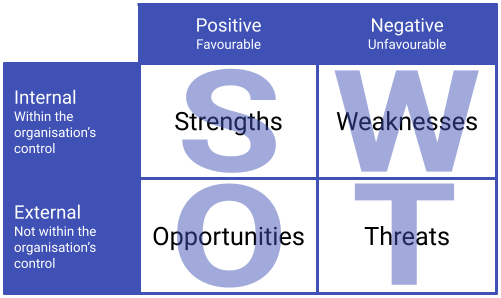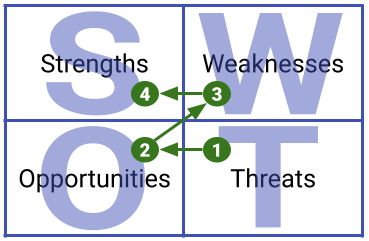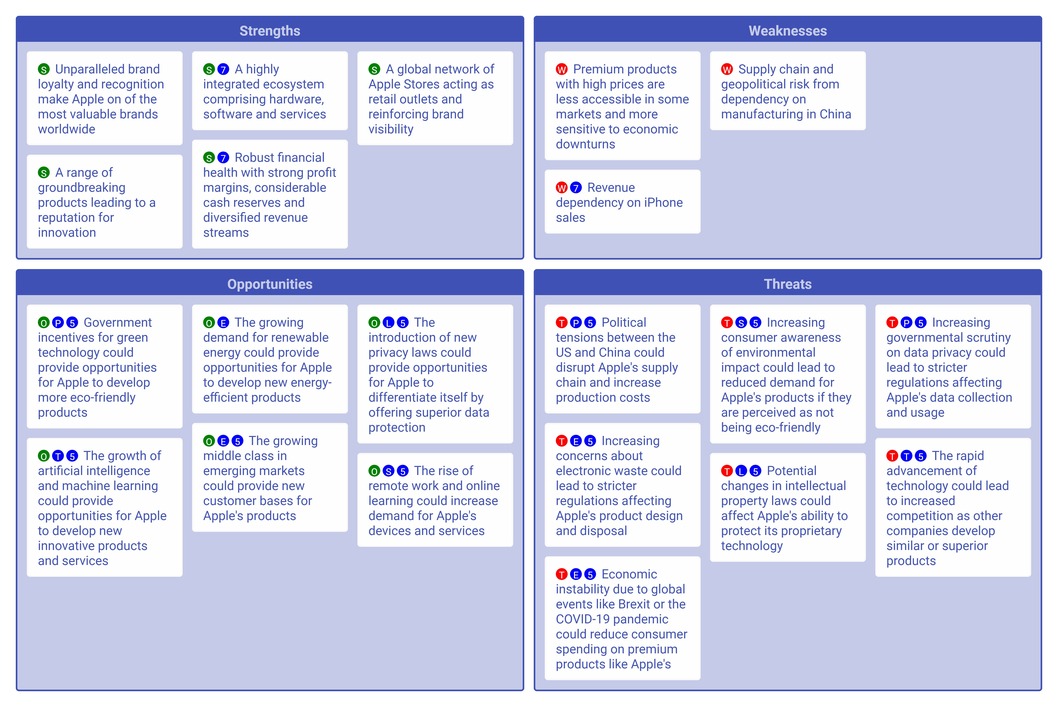 What is a SWOT analysis?
What is a SWOT analysis?
A SWOT analysis is a strategic planning tool that helps organisations assess their Strengths, Weaknesses, Opportunities, and Threats. It provides a clear snapshot of an organisation’s current position and supports decision-making to achieve its goals.
As one of the most widely recognised strategy frameworks, SWOT analysis remains a popular and enduring tool for business strategy development.
What is SWOT analysis used for?
The SWOT analysis can be incredibly useful as:
- a lite or quick and dirty strategy analysis,
- a precursor to assist in
- planning a more comprehensive strategy analysis and
- selecting the most appropriate more complex tools to use, or
- a means of collating and summarising the outputs from more sophisticated techniques.
It can be used:
- In strategy workshops.
- For competitor analysis.
- For a specific strategic goal.
- For the organisation as a whole or for a business unit, division, team or even an individual within it.
What does a SWOT analysis look like?
A SWOT analysis is conventionally represented as a 2X2 matrix with:
- Strengths listed in the top left quadrant,
- Weaknesses in the top right,
- Opportunities in the bottom left, and
- Threats in the bottom right quadrant.
You can see an example of a SWOT analysis here.
Understanding the Structure and Logic of the SWOT
 SWOT analysis divides your strategic insights between:
SWOT analysis divides your strategic insights between:
- positive (favourable) or negative (unfavourable)
and - internal (within the organisation's control) or external (not within the organisation's control).
This structure ensures that your SWOT analysis is MECE (Mutually Exclusive and Completely Exhaustive). That is, each and every strategic insight has exactly and only one place in the SWOT.
The Strengths and Weaknesses represent the internal dimension of the business unit under consideration. These cover factors which are or should be under management's control. A McKinsey 7-S analysis is a good way of making sure you've covered all your bases. StratNavApp.com will help you do this.
The Opportunities and Threats represent the business unit's external environment. These cover factors which are typically not under management's control. A PESTEL analysis or Porter's 5 Forces analysis, is a good way of going after these. StratNavApp.com will help you do this, as well.
It is sometimes tempting to blur the boundaries between positive and negative factors, particularly in the external dimension. After all, is every Threat not really just an Opportunity not yet grasped? This may make us feel more optimistic and proactive. But it doesn't really add anything to the analytical process. So, you should simply consider whether the factor under consideration would be likely to take the organisation closer to or further from its goals if you do nothing about it.
How to do a SWOT analysis
The best practice for producing a great SWOT analysis that delivers results is to:
Define your Scope and Objective
Start by clearly defining the scope and objective of your SWOT analysis. This could be for the overall business strategy, a specific area (division, department, team) within the business, a specific project or initiative, or a specific business decision. Having a clear objective helps focus the analysis and ensures it addresses relevant aspects
Gather Resources and Data
Collect all relevant data, both internal and external. This includes financial records, market research, competitive intelligence, and feedback from stakeholders. Involve a diverse group of team members to ensure a broad perspective.
Identify Opportunities
To identify an organisation's opportunities, ask:
What is happening or could happen which, if you do nothing about it, could have a positive impact on the organisation and its ability to achieve its goals?
Identify Threats
To identify an organisation's threats, ask:
What is happening or could happen which, if you do nothing about it, could have a negative impact on the organisation and its ability to achieve its goals?
Identify Strengths
To identify an organisation's strengths, ask:
What resources or capabilities does the organisation have that competitors would find difficult to get and which could:
- help it to achieve its goals,
- help it to realise the opportunities identified above, and/or
- help it to defend itself against the threats identified above?
Identify Weaknesses
To identify an organisation's weaknesses, ask:
What resources or capabilities does the organisation lack compared to competitors and which could:
- prevent it from achieving its goals,
- prevent it from realising the opportunities identified above, and/or
- prevent it from defending itself against the threats identified above?
Summarise the results in a SWOT Matrix
Create a matrix with four quadrants, each dedicated to one component of SWOT. This visual representation helps in quickly identifying the relationships between different elements and developing strategic plans.
You can use our template (below).
Analyse and Develop Strategies
Analyse the SWOT matrix to develop strategies that leverage strengths and opportunities while addressing weaknesses and threats. This might involve:
- Using strengths to capitalise on opportunities
- Addressing weaknesses to mitigate threats
- Developing contingency plans for identified threats
- etc.
Maintain and Update
A SWOT analysis should be a living document. Regularly update it to reflect new data, changes in the market, and progress on strategic initiatives. This continuous improvement process helps in staying agile and adaptable. Review your strategies as your SWOT analysis changes.
How to approach a SWOT
What order to approach your SWOT in
 It is customary to approach the SWOT in reverse order. That is, Threats, then Opportunities, then Weaknesses, then Strengths.
It is customary to approach the SWOT in reverse order. That is, Threats, then Opportunities, then Weaknesses, then Strengths.
This encourages an outside-in rather than inside-out approach which is generally considered better for strategy.
However, the order in which you tackle the quadrants in your SWOT is less important than that you arrive at the end with a concise and insightful analysis of the situation in which the organisation finds itself.
It is fairly common to end up iterating between the segments in an unpredictable order, especially towards the end of the exercise. This is because the 4 quadrants are interdependent on each other.
Resource-based versus Market-based views
The order in which you tackle your SWOT can be related to the Resourced-based View (RBV) and Market-based View (MBV) of strategy.
The RBV starts with what the company has and looks at what it can do with it. This aligns with starting with Strengths and Weaknesses before considering Opportunities and Threats.
The MBV starts with what the market wants and then considers how the organisation can deliver it. This aligns with starting with Opportunities and Threats before considering Strengths and Weaknesses.
How to write good strategic insights
Each answer to the above questions should be added to the appropriate quadrant of the SWOT as a strategic insight. See these tips to ensure your strategic insights are actually insightful.
Example of SWOT analysis
The following example shows what a SWOT analysis of Apple might look like.

See SWOT Examples for more examples and disclaimer.
Benefits of SWOT analysis
The main benefit of SWOT analysis is its simplicity and flexibility. It can be used to capture a very wide variety of strategy insights.
Using the SWOT analysis in conjunction with the TOWS framework provides a solid basis for setting strategic goals.
You can do a quick and dirty SWOT analysis at the beginning of your process to help you decide where to focus more attention and dig deeper. You can use a SWOT analysis at the end of a process to summarise the strategic insights you've gained across all of your strategic analysis.
Common misconceptions about SWOT analysis
Some commentators have argued that SWOT analysis is outdated and too simplistic.
Whilst it is one of the old strategy models still in use, it has stood the test of time and remains a key framework. Its simplicity provides an elegance and flexibility that make it very useful across a wide range of situations.
The popularity of SWOT analysis means it is very widely used. Often it is used by people who lack the skill and guidance to do it well. So it is true that many SWOTS are poorly done. That does not mean that it cannot and should not be done well. StratNavApp.com will provide you with plenty of guidance to ensure you do. (See, for example, Are your strategic insights insightful?)
Where to find the SWOT analysis (Template)
StratNavApp.com includes a fully collaborative and interactive SWOT Template which is tightly integrated into its overall strategy framework. You can easily add, edit, remove and sort items on your SWOT, as well as share it with collaborators and access it from anywhere on any device.
To find your SWOT analysis:
- Sign Up or Sign In to StratNavApp.com.
- Select the project you want to work with.
- Click on "Analysis" on the main menu.
- Click on "Insights" on the drop-down menu that opens up.
- Select "SWOT" on the model selector on the page that follows.
Once you've completed your SWOT Analysis you can also:
- Download it as an image to paste into another document, presentation or email by clicking the "download image" button
- see to the right and Downloading Images from StratNavApp.com
- Print it to paper or a PDF
- Include it in a strategy plan or report - see Generating Strategy Reports from StratNavApp.com
How to use AI to develop your SWOT
StratNavApp's built-in AI can help you develop a better SWOT.
It will use everything you've already told it about your business and your strategy to make your SWOT as insightful as possible.
If you've told it nothing yet, consider doing a Business Model Canvas first. But even if you tell StratNavApp.com nothing else first, it will still be able to help.
- Use AI to identify Opportunities and Threats.
To identify Opportunities and Threats, visit the PESTEL analysis and use the AI there.
Opportunities and Threats identified on the PESTEL analysis will automatically appear on your SWOT. - Use AI to identify Strengths and Weaknesses
 Click the #stratBot icon (see to the right) to get the AI to suggest the questions you should ask to identify Strengths and Weaknesses.
Click the #stratBot icon (see to the right) to get the AI to suggest the questions you should ask to identify Strengths and Weaknesses.
The AI can't identify your Strengths and Weaknesses directly as it does not have internal information about your business. But it can provide you with the best questions that will allow you to answer them.
Deleting versus filtering items on a SWOT analysis
All of your strategic insights including those shown on your PESTEL, 5 Forces or McKinsey 7-S models will also appear on your SWOT analysis.
You can't delete an item from your SWOT without also deleting it from those other models.
However, you can filter your SWOT according to the impact score attached to each insight. So, for example, you can hide all insights with low-impact scores.
To filter your SWOT:
- Set different impact levels for each insight - simply click on the insight card and slide the impact slider.
- Filter your SWOT - click on the filter icon towards the top right corner of the SWOT and move the slide which appears to to the right to filter out insights that impact below that.
If you do want to delete an insight from your SWOT (and other insight-based models) you can click on the item, scroll towards the bottom of the page, and click on the trash icon.
Download or export your SWOT Analysis
Once you've completed your SWOT analysis, you can:
- Download it as a PNG image: on the SWOT analysis screen, click the download image () button towards the top right of the screen.
See also Downloading Images from StratNavApp.com. - Create a report in HTML or Microsoft Word format: Select Reports and StratML on the main menu, select SWOT and any other components you want to include in your report, then click "HTML Report" or "Microsoft Word Report" near the top of the screen.
See also Generating Strategy Reports from StratNavApp.com
What to do once you've completed your SWOT analysis
Once you've completed your SWOT analysis you can:
- Do a competitor analysis.
- Develop some future scenarios - this can be especially useful if your SWOT analysis shows that your organisation faces high levels of uncertainty in its external environment.
- Proceed directly to setting your strategic goals - you may find the TOWS framework helpful in using the SWOT analysis to set strategic goals.
Video: How to do a SWOT Analysis
Covering much of the content of this article.
See also:
- 13 tips and techniques to help you do a better SWOT analysis
- The consistently popular SWOT analysis
- Video Introduction Course: Chapter 4: SWOT Analysis
- What's the difference between SWOT and PESTEL analysis?
